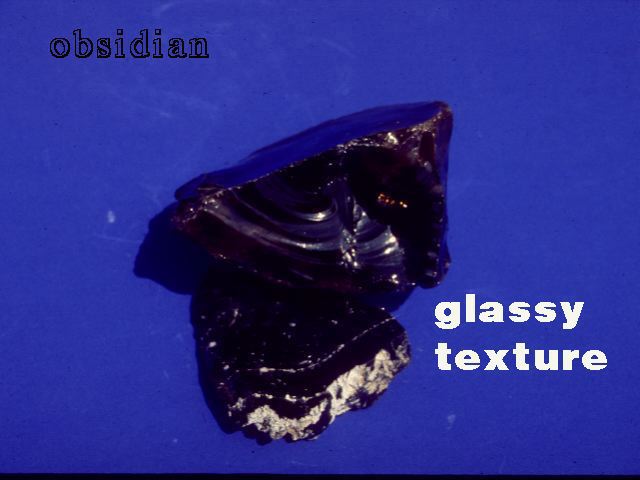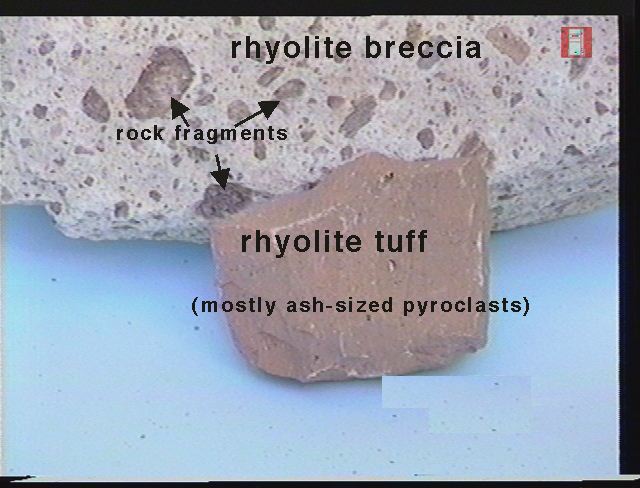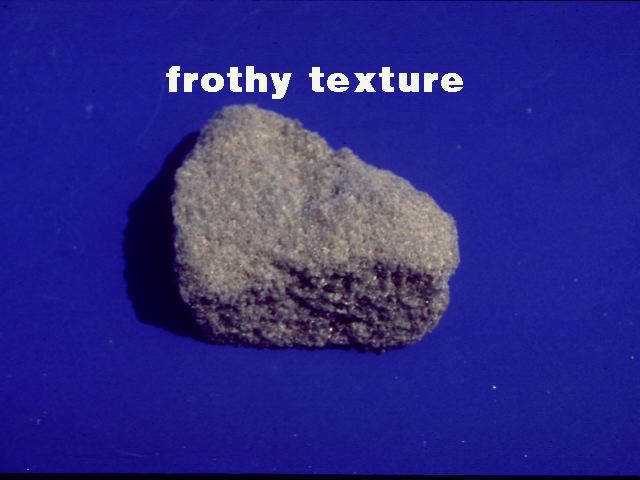
Igneous Rock Textures
COARSE GRAINED TEXTURE (PHANERITIC), mineral grains easily visible (grains several mm in size or larger)

A hand specimen of granite with phaneritic (coarse grained) texture. Principal minerals are Potassium Feldspar, Biotite Mica, and Quartz.
B) FINE GRAINED TEXTURE (APHANITIC), mineral grains smaller than 1mm (need hand lens or microscope to see minerals)

A hand specimen of basalt with aphanitic (fine grained) texture. The dark color is due to abundant dark colored minerals (pyroxene, hornblende).
C) PORPHYRITIC TEXTURE (MIXED FINE AND COARSE)

A hand specimen of a volcanic rock with porphyritic texture. Larger crystals of plagioclase feldspar (white), are suspended in a groundmass/matrix of fine grained dark and light minerals (thus the gray color). The plagioclase had already crystallized at depth in the underlying magma chamber, and was suspended in a magma. When the lava erupted it cooled down rapidly, and formed the fine grained matrix around the already existing plagioclase crystals.
D) GLASSY TEXTURE (NO CRYSTALS VISIBLE)

A handspecimen of obsidian (volcanic glass). The cooling occurs so rapidly that no crystals have time to form. Thus, we have a glass (no ordering like in minerals) and the rock breaks like glass does, with a conchoidal fracture.
E) PYROCLASTIC TEXTURE (VOLCANIC ASH AND TUFF DEPOSITS)

Handspecimens of a rhyolite breccia and a rhyolite tuff. Both are volcanic rocks of granitic composition, that formed due to explosive volcanism. Bits of preexisting volcanic rocks are reduced to rubble, mixed with newly erupted material, and blown up in the air. As the material settles down we get rocks with an obvious fragmental component (rhyolite breccia), and if it is very fine we may only see those fragments with a microscope (rhyolite tuff).
F) VESICULAR TEXTURE (Open spaces, bubbles)

If magma contains dissolved gases, these will tend to bubble out when the magma comes to the surface (just like CO2 bubbles out of a bottle of Seltzer). Because cooling is rapid, not all the gas may escape from the lava flow and bubbles (vesicles) are preserved.
G) FROTHY TEXTURE (abundant small bubbles, more bubbles than rock)

Handspecimen of pumice with frothy texture. Pumice is volcanic glass with abundant bubbles, so many in fact that pumice often floats in the water. The sharp edges of open bubbles on broken surfaces make this rock useful as an abrasive. Pumicestones that are sold in drugstores for skincare, work on that principle.